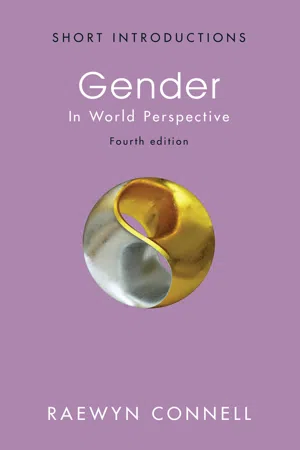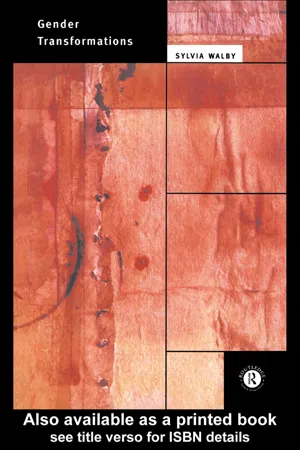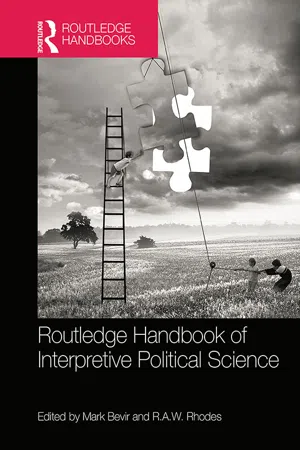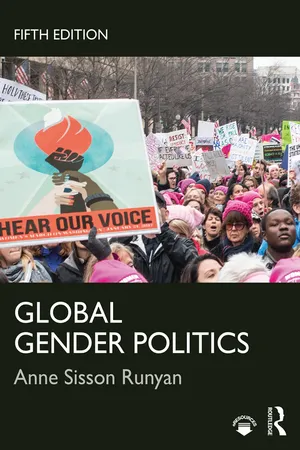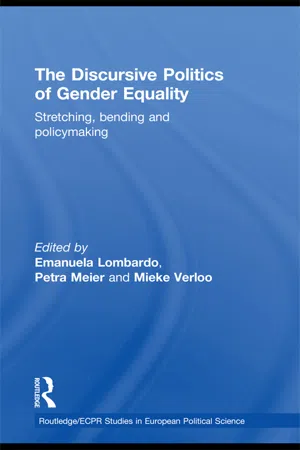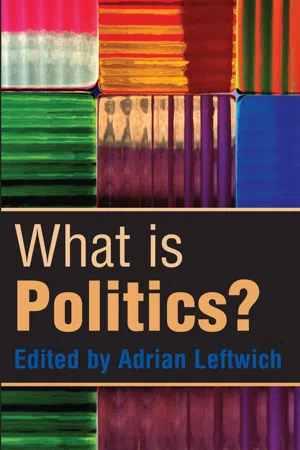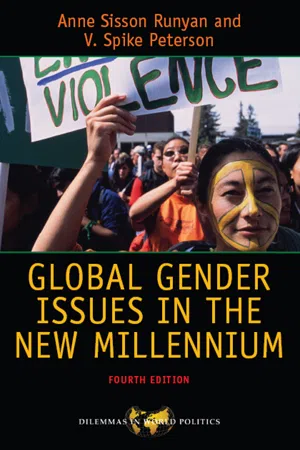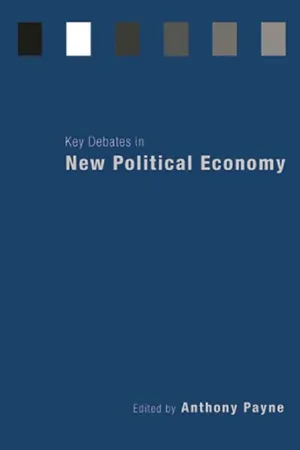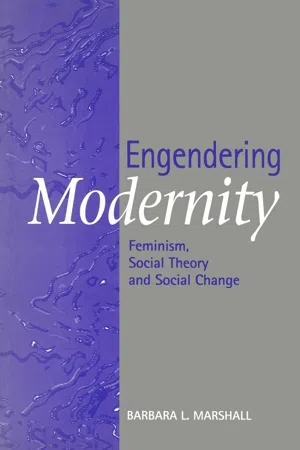Social Sciences
Gender Politics
Gender politics refers to the ways in which power dynamics, social norms, and institutions intersect with gender identity and expression. It encompasses the struggle for gender equality, the impact of gender on political decision-making, and the ways in which gender shapes societal structures and policies. Gender politics also involves the examination of how gender intersects with other social categories such as race, class, and sexuality.
Written by Perlego with AI-assistance
Related key terms
10 Key excerpts on "Gender Politics"
- 8 Gender PoliticsIf change in gender relations is always possible, as chapter 5 showed, then it can become the goal of social action. This is a simple definition of Gender Politics – the struggle to alter a gender order, or to resist change. This chapter will consider the many forms taken by Gender Politics, and the stakes for which people contest. This means looking at the central institution in politics, the state, in terms of its gender regimes and policies; and at the global arenas in which some of the major issues in Gender Politics are now fought out.
Forms of Gender Politics
Historically the most important movement in Gender Politics has been feminism. Feminist awareness and feminist campaigns are the source of most of the research discussed in chapter 3 , most of the gender theories discussed in chapter 4 , most of the problems discussed in chapters 6 and 7 , and most of the political agendas discussed in this chapter.Not all political movements among women are feminist. Raka Ray’s (1999) study of women’s politics in India gives a clear example. The Communist Party of India (Marxist), the long-term governing party in the province of West Bengal, established a women’s organization called Paschim Banga Ganatantrik Mahila Samiti. This functioned mainly to implement the official line coming down from the male leadership of the Party – a line that insisted on solidarity between working-class women and men, not on the specific interests of women. Consequently the women of the Samiti, while working for women’s economic and educational advance, shied away from anything that implied a direct challenge to men. They did not, for instance, make a public issue of men’s violence against women, though that has been a central issue for feminists all over India.This pattern is not peculiar to India. Postwar Japan, for instance, saw a remarkable growth of women’s organizations. Women had gained the vote, and in the 1950s and 1960s were an important constituency. As Tanaka Kazuko (1977) describes, political parties controlled by men set up women’s auxiliaries to claim this constituency. There were also big state-based women’s organizations. But these organizations were tied to a patriarchal political system. When the Women’s Liberation movement erupted, it represented a radical break. As in the United States and Europe, the claim for autonomous - eBook - ePub
- Sylvia Walby(Author)
- 2003(Publication Date)
- Routledge(Publisher)
7: Gender Politics AND SOCIAL THEORY
INTRODUCTION
The significance of politics for the analysis of gender relations has often been underestimated. In particular, the balance that women choose between domestic and paid employment is crucially structured by the environment created by state policies. These include policies expressly oriented to the reconciliation of working and family life, such as publicly funded child care, as well as the regulation of gender relations in employment such as the Equal Pay and Sex Discrimination Acts. There are also important policies which have an indirect effect on the sexual division of labour through the regulation of the wider social environment within which men and women make gendered decisions. This includes policies regulating marriage, such as determining the conditions under which divorce can be obtained; those regulating aspects of sexual practice and fertility, such as the availability of legal abortion and contraception; the wider environment, such as policies towards women’s safety and the policing of sexual harassment and other forms of male violence; and cultural institutions, such as the regulation of the circulation of pornographic imagery. These state policies are the outcome of political activity more broadly defined.FOUR APPROACHES TO POLITICAL SOCIOLOGY
The treatment of gender in political sociology has undergone major changes in recent years. There are four types of approach. The first is to ignore gender as if it were not relevant or did not make any difference, or only refer to women in a brief aside or footnote. The second is the stage of critique when the flaws and fallacies which stem from ignoring gender are exposed. The third stage is to add on the study of women as a special case, as compensation for their previous neglect. The fourth is the full theoretical integration of the analysis of gender into the central questions of the discipline itself. These types of approach are, to a great extent, dependent upon the prior ones being carried out in turn. The flowering of empirical work on women in politics cannot take place until the feminist critique is established. The last stage, of full theoretical integration, cannot take place until a body of empirical work which relates to both sexes, and not just one, has been built up. After discussing the early approaches, this chapter makes a case for the nature of the integration of Gender Politics into the mainstream political sociology. - eBook - ePub
- William Outhwaite, Stephen Turner, William Outhwaite, Stephen Turner(Authors)
- 2017(Publication Date)
- SAGE Publications Ltd(Publisher)
7 Gender and Political SociologyCelia ValienteIntroduction
In all societies, women (as a group) have less access than men (as a group) to political power, economic resources, and social prestige. Thus, gender is a central perspective in political sociology, which is defined here as the study of the relationship between state and society. In the past five decades, scholars have produced an immense set of studies on gender in political sociology, and the aim of this chapter is to provide a state of the art of this scholarship.This review of literature is necessarily limited due to space constraints and the vast range of the academic field to be assessed. This overview focuses mainly on works based on empirical research.1 When deciding what works to review, I selected them if their object of study could be considered political sociology, regardless of the institutional affiliation of their authors (departments of political sociology, sociology, political science or others). I try to cover works that were path-breaking some years or decades ago, and also some very recent publications. Because gender scholarship originally developed by including women among legitimate objects of study in political sociology, this review principally assesses studies on women. Nonetheless, it should be acknowledged that gender affects both women and men. Most authors whose works are mentioned here are women, because gender scholarship was elaborated chiefly (but not exclusively) by female scholars. These happen to be feminist, in the sense that they believe that women's subordination (however defined) is pervasive, wrong, and needs to be reversed.Some countries (the United States and to a lesser extent the rest of Western industrialized countries) are much more studied than the remaining polities of the world. Thus, this geographical imbalance is inevitably reflected in this article. In comparison with many other parts of political sociology, gender scholarship is more often elaborated with qualitative methods and based on single case studies on a limited number of cases, and less often elaborated with quantitative methods using a big-N (large number of) cases. - Mark Bevir, R. A. W. Rhodes, Mark Bevir, R. A. W. Rhodes(Authors)
- 2015(Publication Date)
- Routledge(Publisher)
25 Gender And Politics
Mary Hawkesworth DOI: 10.4324/9781315725314-25From the classic works of Western political theory to empirical analyses of contemporary political life, politics has been construed as male terrain. Although the absence of women from practices of governance, decision making, and collective determination was variously attributed to women’s biological incapacity, intellectual inferiority, lack of interest, or lack of qualifications, it was seldom linked to institutional contexts that enable and constrain individual action or structural forces that ensure that all individuals are not equally unfettered subjects. The field of gender and politics research was launched to challenge received views of women’s political engagement. Interrogating works of political theory, comparative politics, international relations, and public policy, feminist scholars have investigated women’s political experiences in relation to men’s, identifying pervasive androcentric bias in established claims about the political world and offering alternative accounts. Feminist approaches to the study of politics have raised a host of questions concerning the nature and extent of women’s political participation, the omission and distortion of women’s political activism in traditional political studies, and the accuracy of long-accepted theories of politics that are premised on the experiences of only half the human population. By incorporating women into their analyses, feminist scholars have excavated aspects of political power and dimensions of political life that challenge long-held views about the nature of the state, practices of democracy, formal equality, and the scope of justice within national and international institutions. They have also raised significant epistemological concerns about the production of political knowledge, the validity of core assumptions about legitimate research techniques, and the importance of incorporating gender as an integral interpretive strategy in the study of the political world. This chapter provides a brief overview of feminist contributions to the understanding of political life.- eBook - ePub
- Anne Sisson Runyan(Author)
- 2018(Publication Date)
- Routledge(Publisher)
At its deepest level, the power of gender as a meta-lens continually normalizes—and hence depoliticizes—essentialized stereotypes, dichotomized categories, and hierarchical arrangements. In these multiple and overlapping ways, the power of gender is political: it operates pervasively to produce and sustain unequal power relations. Thus, lenses that ignore or obscure how gender operates systemically and structurally are conceptually inadequate for understanding how power works in global politics and politically inadequate for challenging interrelated social injustices and global crises. Intersectional Gender Analysis Contemporary gender studies that partake of intersectional analysis, which holds that gender cannot be understood in isolation from other identity categories and relations of inequality, recognize that there are multiple genders, as well as sexes, in part because race/ethnicity, class, sexuality, and other cultural variations shape gender identities and performances. The concept of intersectional analysis emerged from the work of black US feminist theorists in the 1980s and beyond (Crenshaw 1991; Collins 1991) who recognized that the lives and experiences of women of color were underrepresented in dominant Western feminist theories about women’s subordination that were based on the experiences of largely white, Western, middle-class, and/or working-class women. Because the particular characteristics associated with femininity and masculinity vary significantly across cultures, races, classes, and age groups, there are no generic women and men, cis or trans. Our gender identities, loyalties, interests, and opportunities are intersected and crosscut by countless dimensions of “difference,” especially those associated with ethnicity/race, class, national, and sexual identities - eBook - ePub
The Discursive Politics of Gender Equality
Stretching, Bending and Policy-Making
- Emanuela Lombardo, Petra Meier, Mieke Verloo, Emanuela Lombardo, Petra Meier, Mieke Verloo(Authors)
- 2009(Publication Date)
- Routledge(Publisher)
‘Gender’ as a conceptual category entered political theory relatively recently to become a specific concept of understanding and criticizing the world of existing inequalities, including politics and power. Gender also became a specific ‘tool’ of feminist political action and later of policymaking. Yet, from the very beginning, it has also been an ‘essentially contested’ concept, marked by ‘slippery terms’ (Squires 1999:54; Eveline and Bacchi 2005:497), because gender was linked with other concepts – especially with equality, difference and diversity. Subject to various discursive interpretations and uses, it was seen as a difference category, as a foundation for equality goals and often as a rather undefined, travelling concept that embraced many meanings. As such, ‘gender’ often proved to operate as an empty signifier that could be arbitrarily ‘filled in’ with diverse meanings by different political actors or institutions. This generated disputes among feminists over its subsequent use in both the analysis and the equality policy arenas (Kahlert 2005; Knapp 2005).The following questions appear significant for feminist gender theory. To what extent and how does the category of gender acquire diverse features, and how do these affect its envisaged political potentials? What kind of gender framings – stretching and bending the meaning of the concept – emerge when gender settles down in specific equality policies? How much are these policies really about gender and gender equality, and how much are they informed by the discourses of feminists and strategies of transformative Gender Politics (see Squires 1999, 2007; Verloo and Lombardo 2007)? Does the found spectrum of gender meanings support or obstruct the visions and strategies of political transformation that aim to challenge existing gender regimes (Walby 2005)?To find some answers to these questions, I will look in this chapter at the various meanings of gender and gender equality that emerge in gender theory and in some areas of policymaking in European Union (EU) countries, and examine how they are discursively constructed, stretched, shrunk, bent and eventually fixed within certain debates and policy processes. I begin with an overview of Western feminist discussions on the contested categories of gender and equality, asking how they envisaged a transformative gender equality politics. After that, I analyse some major patterns of the gendering of concrete equality policy issues. I take up the question of how much these patterns of gendering are informed by transformative, feminist or other gender framings. Finally, I reflect on some challenges that these diverse discursive uses of gender – processes of gendering – generate for transformative gender equality politics. - eBook - ePub
What is Politics?
The Activity and its Study
- Adrian Leftwich(Author)
- 2015(Publication Date)
- Polity(Publisher)
There is an oddly paradoxical relation between politics and feminism. On the one hand, the traditional institutional manifestations of politics located in government have been notoriously resistant to the incorporation of women, their interests or perspectives. Politics has been more exclusively limited to men and more self-consciously masculine than any other social practice (Brown, 1988: 4). On the other hand, feminism has always been explicitly political. Feminism, as Anne Phillips tells us, ‘is politics’ (Phillips, 1998: 1). Its project, to realize fundamental transformations in gender relations, is overtly political in the sense that it seeks to make more equal the power relations between men and women.The apparent tension between the claim that ‘feminism is politics’ and that politics has been exclusively limited to men lies in the different notions of politics employed here. Women have largely been excluded from the political, where politics is defined as the institutional forum of government. But when it is defined primarily as a process of negotiation or struggle over the distribution of power it becomes evident that, far from being excluded from politics, women have both shaped and been shaped by its operation. Feminist theorists would appear to be claiming both that the political is explicitly masculine and excludes women, and also that women are engaged in political struggle to alter existing power relations between the sexes. The paradoxical nature of these two statements subjects the political itself to scrutiny. It also raises questions about the nature of feminist objectives in relation to the political: is the ambition to include women in a political from which they are currently excluded, or to reconfigure a political by which they are currently oppressed, or perhaps both?Thus, if there is a distinctively feminist answer to the question ‘what is politics?’ it is, in light of the argument above, an answer that takes two parts. The first part entails an endorsement of the ubiquity of politics, from which there follows a determination to reveal the artificial and unsustainable nature of existing attempts to maintain strong boundaries around a political realm. The second part entails a commitment to exploring and advocating ways in which social relations might be ordered differently, such that they embody a norm of gender justice. - No longer available |Learn more
- Anne Sisson Runyan(Author)
- 2018(Publication Date)
- Routledge(Publisher)
Clearly, stereotypes and situational constraints shape the gender of political activism, but the recurring differences in women’s and men’s participation must also be examined in relation to large-scale, interacting, and enduring social structures. Here we refer broadly to sets of power relations and/or social-cultural institutions that determine the boundaries of individual behavior. Understanding why so few women hold political power requires understanding how social structures and their interaction make it much more difficult for most women (than for most men) to seek and secure political office. Although primary gender socialization occurs in childhood, the hierarchical dichotomy of masculine-feminine is enforced throughout our lives. The gender dimensions of multiple social structures interact and in effect “discipline” individual behavior to conform to stereotypes.For example, traditional religious belief systems and institutions play an important role in perpetuating images of women that deny them leadership positions. All too frequently, women are portrayed as either the source of evil (the uncontrollably sexual whore) or the model of saintliness (the self-sacrificing virgin). Neither is an appropriate identity for political leadership. In addition, the vast majority of religious institutions themselves exclude women from top leadership roles. No matter how this exclusionary practice is legitimized, it in fact sends a clear and unequivocal message that reinforces gender stereotypes: that women are not equal to men and that they cannot be trusted with or lack the qualifications for positions of authority and power.Religious beliefs interact with and may reinforce other cultural sources of gender stereotyping. This is generally the case in regard to identifying the home/family as woman’s sphere and the public/politics as man’s sphere. It can also be quite explicit, as in the seclusion of women (purdah - eBook - ePub
- Anthony Payne(Author)
- 2006(Publication Date)
- Routledge(Publisher)
5 How (the meaning of) gender matters in political economyV. Spike Peterson
Work cannot be understood without examining how gender is embedded in all social relations.1Our collective fear [is] that the new political economy will fail to adopt a gendered analysis at its core, and will implicitly accept the androcentric bias that has characterized the discipline to date.2What is the state of debate regarding gendered political economy? Answering this question depends on the existence of a debate, who is presumed to be participating and, especially, how we understand ‘gender’. Among self-proclaimed feminist scholars we can readily identify a range of positions on ‘gender and political economy’. While disciplinary locations prompt some of the variation,3 the most telling differences – or points of debate – reflect varying theoretical (epistemological, methodological) orientations to the study of gender. The range of feminist research constitutes a continuum of overlapping positions that (as clarified below) reflects varying positivist and constructivist (also postmodernist/poststructuralist) orientations. The former mixes feminist and traditional political economy tools to study how men and women – gender understood empirically – are differently affected by, and differently affect, political economy; the latter foregrounds the feminist tool of ‘analytical gender’ to study how masculinity and femininity – gender understood as a meaning system – produce, and are produced by, political economy. Hence, there is a range of positions, which means that, while feminists share a commitment to the centrality of gender, they do debate how to study it.It is more difficult to assess how and to what extent less visibly ‘feminist’ scholars participate in the debate. While we see little evidence that political economy scholars assume the centrality of gender, in the last 10 years we do observe more attention to the category of ‘women’ (for example, in labour markets and social movements) and more references to ‘gender’ in a variety of publications. We also observe the inclusion of ‘gender-thematic’ articles in journal special issues,4 - eBook - ePub
Engendering Modernity
Feminism, Social Theory and Social Change
- Barbara L. Marshall(Author)
- 2013(Publication Date)
- Polity(Publisher)
5Gender Politics: Regulation and ResistanceDominant socialist feminist theories of the production and reproduction of ‘gender identity’ and the resulting asymmetry of gender relations have largely failed to take into account the conflictual and contradictory character of those relations, tending to reify them in a way which makes their regulation and reproduction relatively unproblematic. Taking instead the perspective on gendered identities as actively interpreted, multiple and often contradictory, this chapter will build on several key areas of theory. First, I will review feminist theories of the state, and sketch out a framework for analysis which examines the regulation of gendered identities embodied in the development of, and policies associated with, modern welfare states. Drawing on theories of ‘moral regulation’, which focus on the political regulation of permissible forms of identity (Corrigan, 1990: Corrigan and Sayer, 1985; Kinsman, 1987; Valverde and Weir, 1988), I will suggest that the state, and in particular the modern welfare state, does not just ‘act’ on subjects, but actively constructs them in particular gendered, raced and classed ways. The second body of theory that I want to build on, and the focus of the latter part of the chapter, is concerned with the emergence of a ‘public sphere’, in relation to the separation of state and civil society in modernity, which may provide space for the formation and constestation of identities (Calhoun, 1992; Cohen and Arato, 1992; Felski, 1989a; Fraser, 1990; Fraser, 1992b; Habermas, 1989b; Habermas, 1992; Keane, 1984). Feminism as a social movement which seeks to reconfigure political discourse and create new identities figures prominently here.5.1 Perspectives on the StateAs Gramsci (1929–35/1971: 271) noted, ‘every state tends to create and maintain a certain type of civilization and of citizen (and hence of collective life and of individual relations)’. As Corrigan and Sayer (1985) put it, ‘States, if the pun be forgiven, state. They define in great detail, acceptable forms and images of social activity and individual and collective identity; they regulate, in empirically specifiable ways much. . .of social life.’ States structure relationships and the parameters for interaction. Yet it is only within the last decade or so that the state has become central to feminist analysis. The tendency in earlier feminist work to separate out one institution – the family – as the primary bearer of gender relations deflected attention from seeing political practice itself as constituted by gender inequalities.
Index pages curate the most relevant extracts from our library of academic textbooks. They’ve been created using an in-house natural language model (NLM), each adding context and meaning to key research topics.
